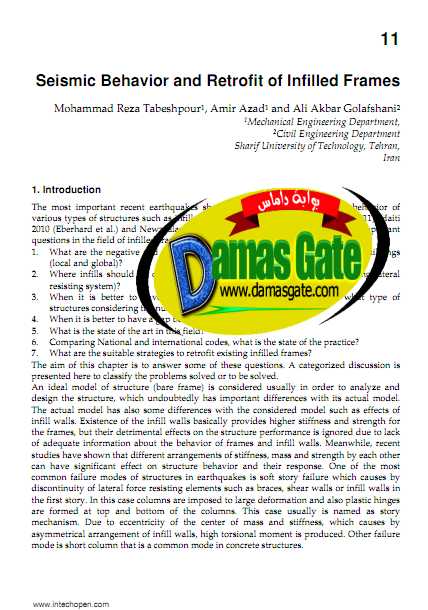Seismic Behavior and Retrofit of Infilled Frames
1. Introduction
The most important recent earthquakes showed the importance of seismic behavior of various types of structures such as infilled frames: Japan 2011 (Takewaki et al., 2011), Haiti 2010 (Eberhard et al.) and Newzealand 2010 (Ismail et al. 2011). There are many important questions in the field of infilled frames, such as:
Code:
1. What are the negative and positive effects of infill walls in various types of buildings (local and global)? 2. Where infills should be considered (in which type of structures, considering lateral resisting system)? 3.When it is better to have interaction between frame and infill? In what type of structures considering the number of stories? 4. When it is better to have a gap between frame and infill? 5. What is the state of the art in this field? 6. Comparing National and international codes, what is the state of the practice? 7. What are the suitable strategies to retrofit existing infilled frames? The aim of this chapter is to answer some of these questions.

A categorized discussion is presented here to classify the problems solved or to be solved.
An ideal model of structure (bare frame) is considered usually in order to analyze and design the structure, which undoubtedly has important differences with its actual model.
The actual model has also some differences with the considered model such as effects of infill walls.
Existence of the infill walls basically provides higher stiffness and strength for the frames, but their detrimental effects on the structure performance is ignored due to lack of adequate information about the behavior of frames and infill walls.
Meanwhile, recent studies have shown that different arrangements of stiffness, mass and strength by each other can have significant effect on structure behavior and their response.
One of the most common failure modes of structures in earthquakes is soft story failure which causes by discontinuity of lateral force resisting elements such as braces, shear walls or infill walls in the first story.
In this case columns are imposed to large deformation and also plastic hinges are formed at top and bottom of the columns.
This case usually is named as story mechanism. Due to eccentricity of the center of mass and stiffness, which causes by asymmetrical arrangement of infill walls, high torsional moment is produced.
Other failure mode is short column that is a common mode in concrete structures.
Download
*